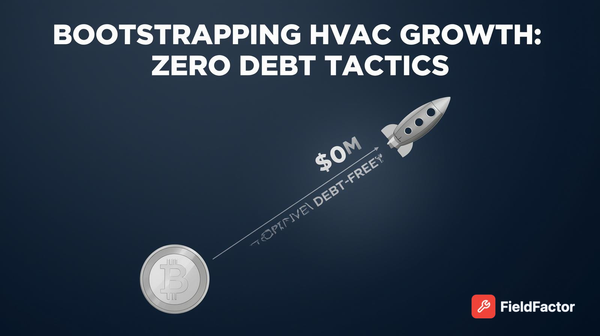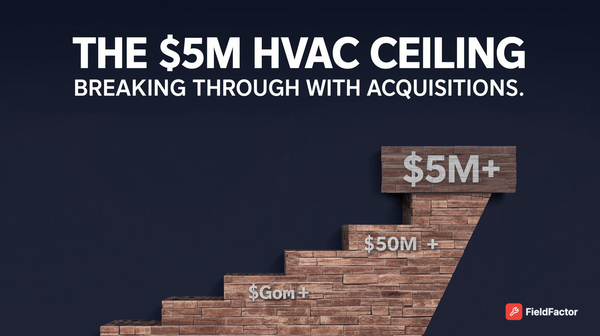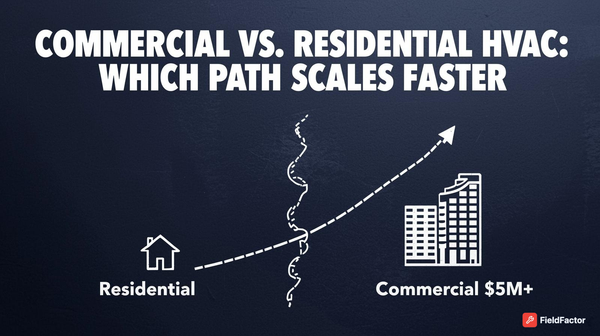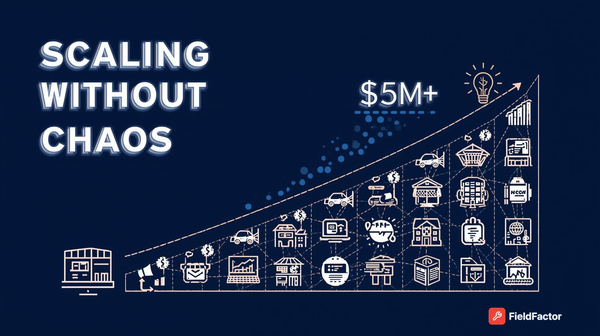How HVAC Maintenance Plans Actually Work (And Why Most Fail)
Learn how HVAC contractors add $60-80k in recurring revenue with maintenance plans. Real strategies, pricing templates, and why 70% fail. No fluff—just what actually works.
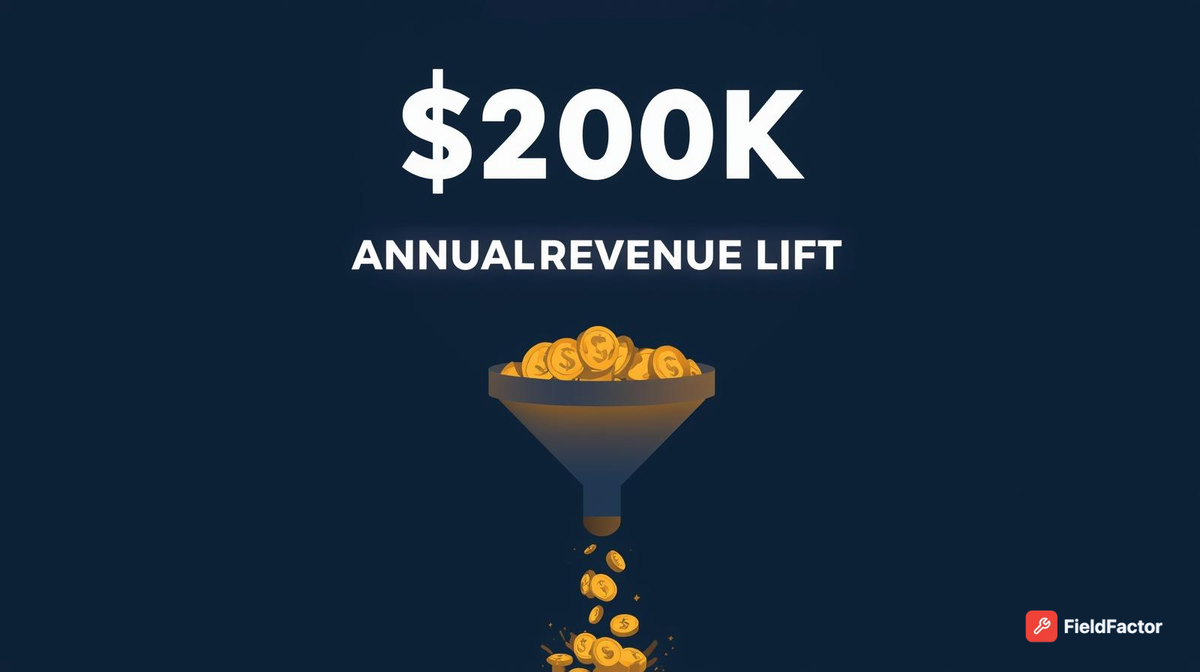
Last January, I talked to an HVAC contractor in Denver who was three weeks away from missing payroll. Summer had been great—he'd cleared $80k in three months. But winter? Crickets. Sound familiar?
The math is brutal. A typical $500k HVAC business drops 30-40% in the off-season. That's $150k just... gone. And you still have trucks to fuel and techs to pay.
Here's what's interesting: the contractors who weather these swings aren't the ones with the best technicians or the flashiest trucks. They're the ones who figured out maintenance plans.
Not as a side hustle. As the backbone of their business.
The Real Problem With Seasonal HVAC Revenue
Most HVAC businesses run like this:
- Summer: phones ringing off the hook, turning away work
- Winter: calling old customers, hoping someone needs a furnace repair
- Spring/Fall: somewhere in between
You're essentially running two different businesses depending on the month.
The contractors I've seen succeed long-term? They've flipped this model. Instead of chasing emergency calls, they've built a base of customers who pay them every month whether the AC breaks or not.
One owner I know in Austin went from $500k to $720k in 18 months. His secret? He got 180 customers on maintenance plans at $150-200/year. That's $30k in guaranteed revenue before he even starts his truck in the morning.
What Actually Works: The Five-Part Framework
1. Design Plans People Actually Want
Forget the complicated three-tier platinum-diamond-elite nonsense. Here's what works:
Basic Plan ($99-129/year):
- One tune-up in spring (AC) or fall (heating)
- 10% discount on repairs
- Priority scheduling
Premium Plan ($199-249/year):
- Two tune-ups (spring and fall)
- 15% discount on repairs
- Priority scheduling + after-hours availability
- Free filter changes (if you're near the customer)
That's it. Don't overthink it.
The key is this: your basic plan should cost less than what they'd pay for a one-time tune-up ($150-200). It's a no-brainer for the customer, and you get predictable revenue.
Real Example: A Florida contractor started with just the basic plan. 40% of his customer base signed up in the first 90 days. Why? Because he positioned it as "you're already calling me every spring anyway—this just locks in a better rate."
2. Make Enrollment Brain-Dead Simple
This is where most contractors screw up. They design a great plan, then make customers jump through hoops to sign up.
Here's the system that works:
During Service Calls:
- Tech mentions the plan while they're on-site
- Shows a one-page flyer with clear pricing
- Can sign them up on the spot (tablet or phone)
- Automatic credit card billing
After Service (Automated):
- Email goes out 24 hours after service: "Thanks for choosing us. Want to save 15% next time?"
- Second email at 30 days if they don't respond
- That's it. No spam.
The contractors using field service software (ServiceTitan, Housecall Pro, Jobber) get 80% enrollment rates. The ones still using paper clipboards? Maybe 20%.
Time Investment: 2-3 months to get this dialed in. One contractor spent $800 on HubSpot's basic CRM and saw enrollment jump from 15% to 70% in six weeks.
3. Convert Your Existing Customers First
You already have a goldmine: your existing customer list.
Pull up everyone who's called you in the last 2-3 years. Segment them:
- Tier 1: Called you multiple times, always pay on time
- Tier 2: Called once or twice, decent customers
- Tier 3: One-time callers or price shoppers
Start with Tier 1. These people already trust you.
The Approach:
- Personal phone call (not email, not text)
- "Hey, I wanted to reach out because you've been a great customer. I'm rolling out a maintenance program and wanted to give you first access..."
- Offer a small incentive: first month free, or waive the sign-up fee
One Midwest contractor converted 60% of his Tier 1 customers in 90 days. That added $55k in recurring revenue before he even touched his marketing budget.
4. Market Like You Actually Want Customers
Here's an uncomfortable truth: if you're not spending money on marketing, you're leaving money on the table.
What's Working Right Now:
Google Local Services Ads ($1,000-2,000/month):
- Shows up above regular Google Ads
- Pay per lead, not per click
- One Texas contractor gets 40-60 leads/month, converts 25% to maintenance plans
- ROI: roughly 3x in the first six months
SEO (Long Game):
- Create city-specific pages: "HVAC Maintenance Plans in [Your City]"
- Write actual helpful content (like this article, but about your local area)
- Takes 6-9 months to see results, but once you rank, it's nearly free leads
Referral Programs:
- Give existing plan members $50-100 for every referral who signs up
- Costs you almost nothing (you're just sharing the profit)
- One California contractor gets 40% of new plan signups from referrals
Timeline: Marketing takes 4-9 months to really kick in. But once it does, you're looking at 50-100 new plan members per year on autopilot.
5. Actually Deliver Great Service
This should be obvious, but I've seen contractors nail everything above and still fail because their service sucks.
The Basics:
- Show up on time (or call if you're running late)
- Actually perform the maintenance—don't just glance at the unit
- Take before/after photos and email them to the customer
- Flag potential issues before they become emergencies
The System:
- Use software to schedule maintenance visits automatically
- Batch customers by geography (don't drive across town five times in one day)
- Train your techs to look for upsell opportunities (but not be pushy about it)
One contractor I know in California cut his drive time by 20% just by batching maintenance visits by neighborhood. That saved him $8k in fuel costs in year one.
What This Actually Looks Like Over 12 Months
Let's say you're at $500k/year right now, mostly seasonal work.
Months 1-3: Setup Phase
- Design your two plan tiers
- Set up enrollment system (CRM/FSM software)
- Start calling Tier 1 customers
- Result: 50-80 plan members, adding roughly $10k in annual recurring revenue
Months 4-6: Momentum Phase
- Launch Google LSA or local SEO
- Implement referral program
- Continue converting existing customers
- Result: 120-150 plan members, $20k-25k in annual recurring revenue
Months 7-12: Scale Phase
- Marketing kicks in (new customers finding you)
- Referrals start compounding
- Hit 200-250 plan members
- Result: $35k-50k in annual recurring revenue
By year two, you're looking at 300-400 plan members and $60k-80k in predictable, recurring revenue. That's enough to cover your base expenses in the slowest months.
Why Most Maintenance Plans Fail
I've seen plenty of contractors try this and give up after three months. Here's why:
They Don't Actually Sell It: You can't just put it on your website and hope people sign up. Your techs need to mention it on every single service call.
They Overcomplicate It: Five tiers, complex pricing, confusing terms. Keep it simple. Two tiers, clear pricing, easy to understand.
They Don't Follow Through: Customers sign up, then never hear from you until you show up a year later. Send reminders, keep in touch, make them feel valued.
They Undercharge: A $49/year plan sounds great, but you'll lose money after you factor in your time and gas. Price it right: $99 minimum for basic, $199+ for premium.
The Bottom Line
Maintenance plans aren't a magic bullet. You still need to be good at HVAC. You still need to show up and do the work.
But they solve the biggest problem in this industry: unpredictable cash flow.
Instead of wondering if you can make payroll in January, you've got $5k-10k coming in every month like clockwork. That's the difference between a stressful business and a sustainable one.
Start simple. Pick one plan tier. Sign up 50 customers in 90 days. Then build from there.
The HVAC contractors making $700k-1M aren't working twice as hard as you. They just figured out how to get paid year-round instead of four months a year.
Next Steps:
- Price out your cost per maintenance visit (labor + gas + materials)
- Add 40-50% margin to that number—that's your plan price
- Write a one-page script for your techs to use on service calls
- Sign up your first 10 customers in the next 30 days
What's stopping you from starting this week?


